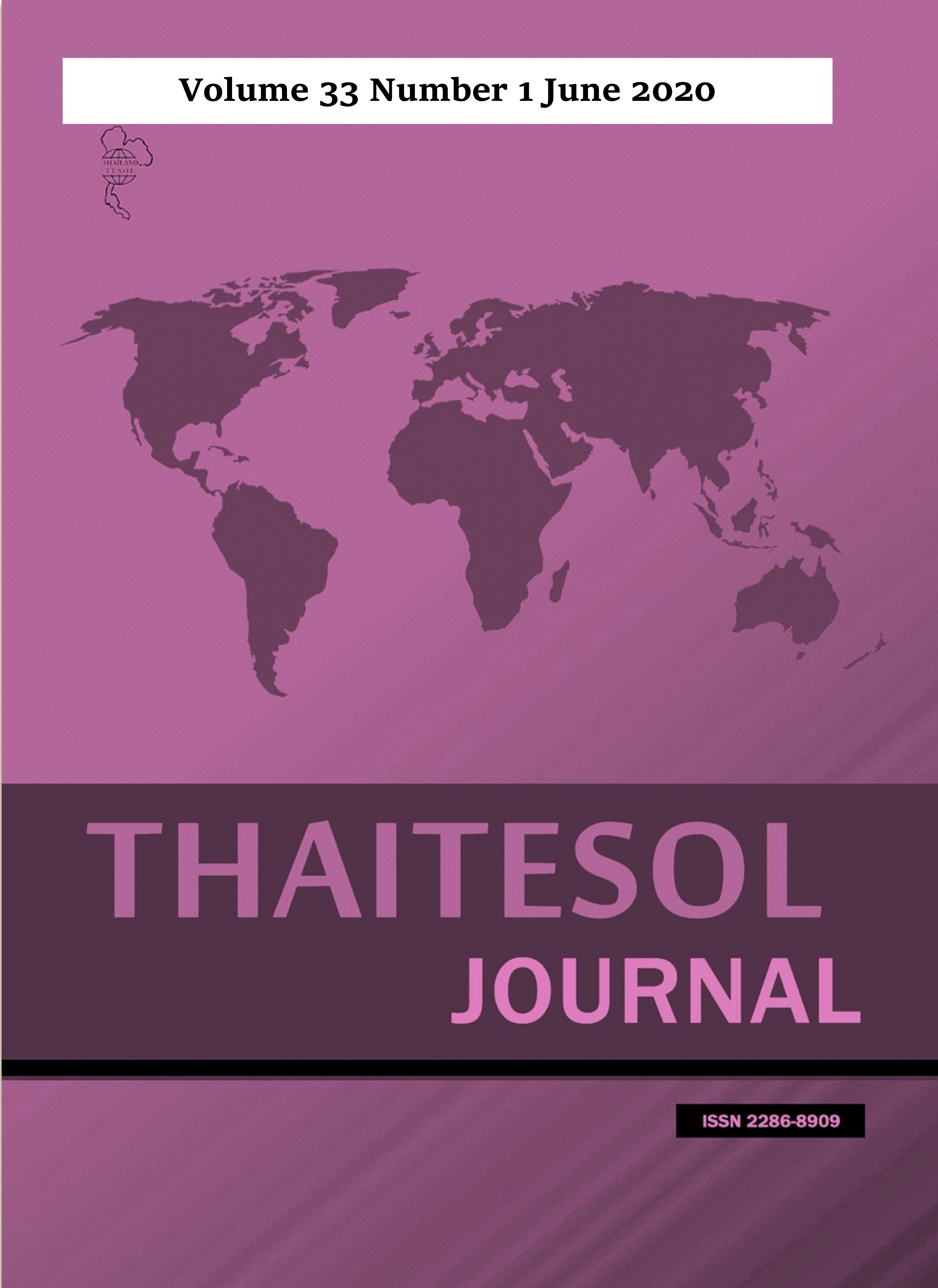Which Word List Should I Teach? Using Word Lists to Support Textbook Vocabulary Instruction
Main Article Content
Abstract
Choosing which vocabulary to teach in an English classroom can be difficult, as many variables such as textbook content and student needs factor into the decision. To aid English instructors in this task, various word lists such as frequency bands from large corpora, research-based word lists, and proficiency levels can be consulted. However, it is not clear which (if any) of these sources are appropriate for any given language classroom, or what subset of the large lists should be taught. This paper attempts to shed light on this complex issue by conducting a case study analysis of textbook materials and student needs in an English for Academic Purposes (EAP) course at a university in Thailand. Reading passages from the course textbook and the vocabulary lists which accompany the texts were compared with the words which the students chose as being important for them to learn. The results of the case study showed that for this textbook and these students, the Common European Framework of Reference (CEFR) B2 level was an appropriate place to look for additional vocabulary. Although these results are specific to one course in one context, they showcase online tools that instructors can use to analyze their own classroom content and student needs, as well as describing generalizable insights that should be considered when choosing textbooks or creating class materials elsewhere.
Article Details
Materials in THAITESOL JOURNAL may be photocopied for educational purposes. Under no circumstances may any part of this journal be photocopied for commercial purposes.
References
Journal of Language Policy, 9(1), 27-44.
Browne, C., Culligan, B., & Phillips, J. (2013). The new general service list: A core vocabulary
for EFL students and teachers. JALT’s The Language Teacher, 34(7), 13-15.
Chen, H., & Lei, G. (2019). Developing a technical words list for research articles in
computer science discipline. English Language Teaching, 12(10), 131-141.
Cobb, T. (n.d.). Compleat Web VocabProfiler v.2.1. Accessed 5 Jan 2020 from
https://www.lextutor.ca/vp/comp/.
Coxhead, A. (2000). A new academic word list. TESOL Quarterly, 34, 213-238.
Coxhead, A. (2011). The academic word list 10 years on: Research and teaching
implications. TESOL Quarterly, 45(2), 355-362.
Engber, C. A. (1995). The relationship of lexical proficiency to the quality of ESL
compositions. Journal of Second Language Writing, 4(2), 139-155.
English Vocabulary Profile Online. (2015). English Profile: The CEFR for English. Accessed
5 Jan 2020 from http://www.englishprofile.org/wordlists/evp.
Franz, J., & Teo, A. (2018). ‘A2 is Normal’ – Thai Secondary School English Teachers’
Encounters with the CEFR. RELC Journal, 49(3), 322-338.
Gardner, D., & Davies, M. (2014). A new vocabulary word list. Applied Linguistics, 35, 305-
327.
Garside, R. (1987). The CLAWS Word-tagging System. In R. Garside, G. Leech and G.
Sampson (Eds.), The Computational Analysis of English: A Corpus-based Approach
(pp. 30-41). London: Longman.
Hsu, W. (2011). A business word list for prospective EFL business postgraduates. Asian ESP
Journal, 7(4), 63-99.
Intathep, L. (2014) European standards set for language. The Bangkok Post. 10 March 2014.
Kanchai, T. (2019). Thai EFL university lecturers’ viewpoints towards impacts of the
CEFR on their English language curricula and teaching practice. NIDA Journal of
Language and Communication, 24(35), 23-47.
Liu, J., & Han, L. (2015). A corpus-based environmental academic word list building and its
validity test. English for Specific Purposes, 39, 1-11.
Martínez, I. A., Beck, S. C., & Panza, C. B. (2009). Academic vocabulary in agriculture
research articles: A corpus-based study. English for Specific Purposes, 28(3), 183-
198.
McNamara, D. S., Crossley, S.A., & McCarthy, P.M. (2010). Linguistic features of writing
quality. Written Communication, 27(1), 57-86.
Mudraya, O. (2006). Engineering English: A lexical frequency instructional model. English
for Specific Purposes, 25, 235-256.
Nagy, W., & Townsend, D. (2012). Words as tools: Learning academic vocabulary as
language acquisition. Reading Research Quarterly, 47(1), 91-108.
Pojanapunya, P. (2019). Tailoring academic words to multidisciplinary EAP classes. TESOL
Journal, 10(3), 1-16.
Poonpon, K., Honsa Jr, S., & Cowan, R. A. (2001). The teaching of academic vocabulary to
science students at Thai universities. Studies in Languages and Language Teaching,
51-63.
Sukying, A. (2010). An analysis of headwords in ELT coursebooks and Ordinary National
Educational Tests in Thailand. LSCAC 2010 Proceedings, 188.
Tangpijaikul, M. (2014). Preparing business vocabulary for the ESP classroom. RELC
Journal, 45(1), 51-65.
Valipouri, L., & Nassaji, H. (2013). A corpus-based study of academic vocabulary in
chemistry research articles. Journal of English for Academic Purposes, 12, 248-263.
Van Lier, L. (1996). Interaction in the Language Curriculum: Awareness, Autonomy and
Authenticity. London: Routledge.
Wan-a-rom, U. (2008). Comparing the vocabulary of different graded-reading schemes.
Reading in a Foreign Language, 20(1), 43-69.
Wan-a-rom, U. (2012). Lexical evaluation of teacher-made coursebooks: Thai case studies
of Foundation English Courses at Tertiary Level. English Language Teaching, 5(8),
146-156.
Wang, J., Liang, S. L., & Ge, G. C. (2008). Establishment of a medical academic word
list. English for Specific Purposes, 27(4), 442-458.
Ward, J. (2009). A basic engineering English word list for less proficient foundation
engineering undergraduates. English for Specific Purposes, 28(3), 170-182.
Watson Todd, R. (2017). An opaque engineering word list: Which words should a teacher
focus on? English for Specific Purposes, 45, 31-39.
West, M. (1953). A General Service List of English Words. London: Longman.
What is the CEFR? (2015). English Profile: The CEFR for English. Accessed 5 Jan 2020
from http://englishprofile.org/the-cefr
Wiriyakarun, P. (2018). Examining Thai EFL learners’ knowledge of academic English
vocabulary. Liberal Arts Journal. 1(1), 119-132.
Yang, M. N. (2015). A nursing academic word list. English for Specific Purposes, 37, 27-38.


